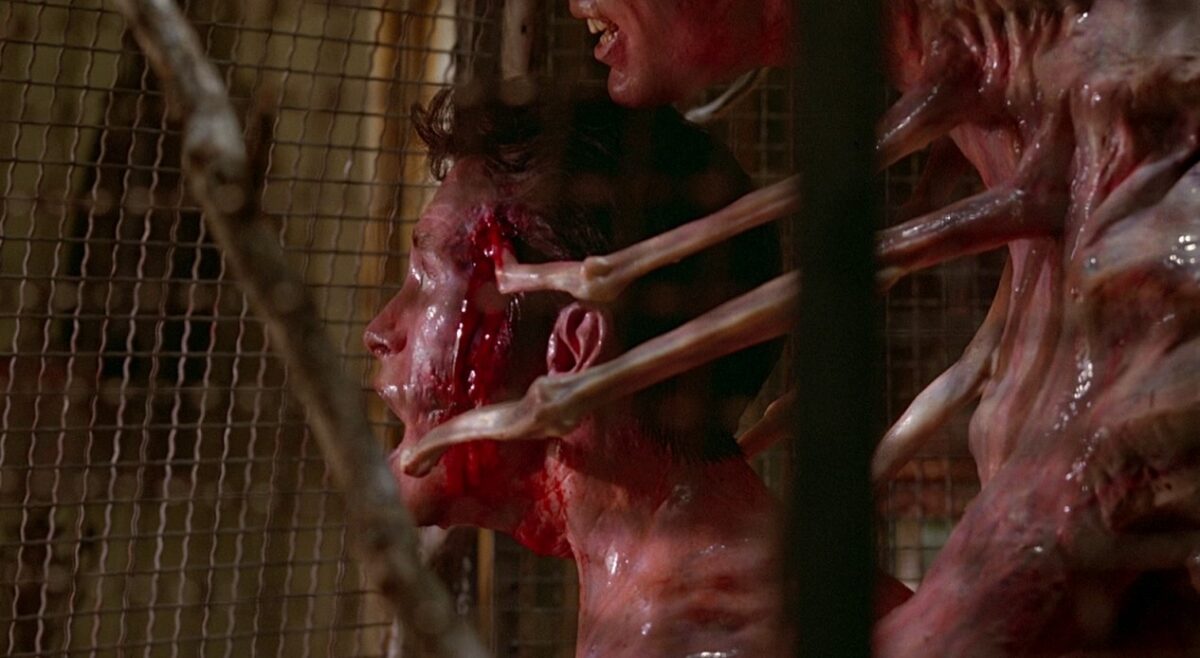“What is “kafkaesque” and what can be classified as such?”. This is a question that deeply pertains not only to the subject matter of this term paper, but to literary studies in general. The legacy of the renowned 20th Century bohemian writer has left an imprint in the works of many other authors across the world. Nevertheless, it is also fair to ask oneself, to what degree? In Twitter a meme in the form of a clumsily written alignment chart makes fun of this tendency to describe any work of art as “kafkaesque” only due to its comment on society or its use of bugs as leitmotif . Regardless of this I believe that there are indeed certain works of art that have a deep intertextual relationship with Franz Kafka’s The Metamorphosis. One of these works is no other than the 1991 film adaptation by Canadian director David Cronenberg of William S. Burroughs’ novel The Naked Lunch. I believe that this movie has many connections to Kafka’s 1915 novel to such an extent that it works as a kafkaesque metamorphosis in its plot and symbology.
Having written that, I must admit that upon my research I found two problems.
First of all, how alike is the film with the written source material by the famous beat writer? Are both works kafkaesque? It is worth noting that although the film and the book share the same name among other characteristics, the movie is absolutely not a conventional adaptation of the novel by any means. As it will be further explained later, the differences between both works are quite numerous that it would not be far fetched to consider both of them as two different works of art by their own merit. That all being said, and although the novel will be referenced to some degree, this term paper will focus for the most part on the film by body-horror maestro, David Cronenberg.
Secondly, as you may have noticed, I have used the term “kafkaesque” instead of “kafkian”, which hosts certain connotations in its suffix “-ian” that escape the naked eye. Damianos Grammatikopoulos from the University of Rutgers throws some light on the use of terminology tied to the name of Kafka. Although on a superficial level, this seems a rather banal subject matter, on a deeper level, even the suffix used here tells us a lot regarding the nature of intertextual relation between both works.
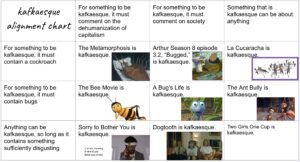
After being able to tackle these issues, I shall be able to write about two major characteristics of the above-mentioned film that undeniably link it to the literary work of Kafka. First, the depiction of bureaucracy; and secondly, the use of bugs as a strong reference to The Metamorphosis.
- THE GAP BETWEEN THE FILM AND THE NOVEL
As David Cronenberg said, before the principal photography of Naked Lunch took place, he planned to create a combination of Burroughsian material, but put it into a structure that wasn’t very Burroughsian. The story (assuming there is distinguishable one) of the literary source material is radically different from that of the film and very difficult to discern. Burroughs wrote in a rather unconventional manner, maybe under the influence of certain narcotics and used the method of cut-ups to assort the paragraphs in a random way.
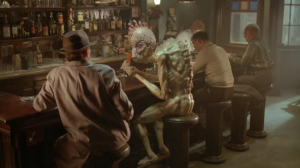
Naked Lunch, the book, is about “Lee the agent”, a drug addict escaping the police that travels to the “West”, while looking for his next fix. During one of these trips he meets very shady characters like a certain Dr. Benway, who elaborates control methods through the use of narcotics, hypnosis and humiliative acts. Somehow in the story the main character gets transported into a place called the “Interzone”, where various gruesome acts of debauchery take place. Then the main character is warped to the beginning of the story in New York, where he kills the police officers that were pursuing him.
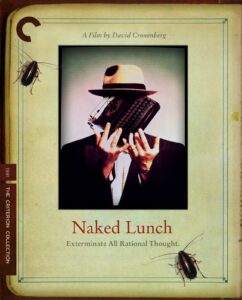
I must confess that it is utterly challenging to even attempt to frame this postmodern tale and I beg the reader of this paper to forgive me for summarizing the story with a blunt stroke of words, that may or may not pay justice to the entirety of Burroughs book. If the latter is the case, a more complete summary has been written by Mr. Uriah Graham.
Like I have stated in the introduction of this paper, the film itself, albeit it also has a dreamy surrealistic nature and although the plot would be completely unorthodox in comparison with the classic narrative of a conventional Hollywood film, it is easier to summarize in contrast to its literary counterpart.
Naked Lunch, the film, tells us the story of William Lee, an exterminator that runs out of powdered poison, while trying to wipe out a colony of cockroaches. It turns out that his wife Joan Lee (the film version of real life Burroughs’ former wife Joan Vollmer) is using the insecticide for recreational purposes. Although at first reluctant, he (William Lee) agrees to use the powder and injects it into his veins, thus going into a psychedelic trip.

I am not going to go into detail, but the film alternates between reality and dream. On the one hand we have William Lee writing Naked Lunch while under the effects of various narcotics and on the other hand he works as an agent for an organization of insects as he tries to “win” Mrs. Lee back. At the end of the film when he is about to enter a new dimension called Annexia together with his wife, the border guards ask him about his profession, to which Lee answers that he is a writer and in order to prove it, he once more does the William Tell number with his wife with unsurprising results. She accidentally dies once more and thus the guards allow William Lee to go through.
As I wrote before, the book and the movie are not synonyms of each other. Although both share characters, situations, places and creatures; the stories are to a great degree different from each other. To add to this, the film conveys certain messages that are completely absent in the original written work. For example, the stand-in of Burroughs’ late wife does not appear at all in his book, but in the film she plays a crucial role as William Lee’s muse and thus as a motor for his writing.
Therefore the film functions as a different work of art by its own merit that is not based on the book, but ultimately inspired in a very lax manner by the original source.
- THE SUFFIX AFTER “KAFK-”
If Kafka were to have written a list of the groceries that he wanted to buy from the local market on a piece of paper, should we then put this list on a pedestal at the same height of all his literary corpus? To this I might add the following question: Is this grocery list kafkian or kafkaesque?
In order to solve this pickle we must rely on the excerpt about the author function in the famous essay What is an Author? by Foucault. Paraphrasing his ideas, the name of an author does not work as a proper name per se, instead it works as a tabula plena where all the most important characteristics of his oeuvre are written. If an hypothetical grocery list written by Kafka were to be found among his belongings in the Kafka Museum in Prague, then most likely, in accordance to Foucault’s definition of an author’s name, it wouldn’t be considered a kafkian literary work if it didn’t were to possess any of the characteristics of the kafkian corpus, even if it had been written by the biological human entity by the name of Franz Kafka.

Of course now the following question would be, which are the characteristics that define Kafka’s oeuvre? I would beg for patience, since this question will be answered in the following chapters.
Instead let us focus on the second question regarding the difference between “kafkian” and “kafkaesque”, to which Dr. Demian Grammatikopoulos gives a detailed explanation in his article Insects and the Kafkaesque: Insectuous Re-Writings in Visual and Audio-Visual Media: “[…]when certain suffixes are added at the end of a name, the name itself becomes an adjective. By attaching the suffix “-ian”, for instance, to the stem of an author’s name (Freud-ian, Lacan-ian, Kafk-ian and Kafka-ian), the newly formed derivative does indeed define the borders of an author’s oeuvre, as Foucault claims, but it does so only when accompanied by certain nouns (text, corpus, oeuvre): “the Freudian corpus”, “the Lacanian oeuvre” etc. […] Words ending in “-esque” represent a further class of suffixes capable of turning a name into an adjective. The online Merriam-Webster definition of the same suffix reads as follows: “in the manner or style of”. As opposed to the suffixes discussed above, adjectives ending in “-esque”, the stem of which contains a name, are not suitable in delineating an author’s oeuvre (the phrase “the Kafkaesque corpus” is rather misleading). Their function is restricted to the denotation of properties that are at play in works composed by an author”.
For this reason, I talk about a kafkaesque and not a kafkian metamorphosis in the thesis of this term-paper. A kafkian metamorphosis would be the transformation endured by Gregor Samsa in The Metamorphosis, while a kafkaesque metamorphosis could fit as a description to any radical physical or mental change of a character in the literary or audiovisual works of any other author other than Kafka, which in this case is William Lee in David Cronenberg’s Naked Lunch.
- THE OPPRESSIVE BUREAUCRACY
At a very superficial level, one could heuristically qualify a work of art as kafkaesque if it contains insects or, more specifically, cockroaches as a leitmotif. But on a deeper level I would like to address Kafka’s disdain for bureaucracy as one of the major characteristics of his literary corpus. In The Castle we have a land surveyor that comes to a village, where he is tangled into the convoluted bureaucracy of the place and in The Trial a man named K. is taken to court for a crime that is never revealed to him.
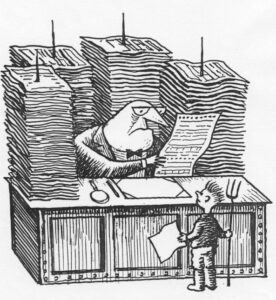
In the works of Burroughs we can also find certain parallelisms in this critique to the bureaucracy, specially in Naked Lunch, where it is mentioned that citizens of Annexia are forced to carry a wad of documents with themselves and that they get arrested on the basis of any minimal irregularity. Plus on the other hand, we have the law, pursuing the main character at the beginning of the novel, possibly criminalizing him due to his addiction, something that was previously explored in Junky. This, almost Orwellian, persecution by members of an oppressive, complex, alienating and convoluted state apparatus is present as an analogy to drugs. While we can infer from Kafka’s work that the overwhelming bureaucracy strips individuals off their dignity if not as citizens, but as human beings; drug addiction does likewise with the drug addicts that also lose their humanity.
All this is literally and visually fleshed out in the film into a paranoia of the heat around the corner dawning on William Lee when he has to escape the law and his involvement as a secret agent in the midst of a drug war (won later by Dr. Benway), when he has to paranoically suspect that his wife among other individuals could be giant centipedes or when he has to write reports for a secret agency. The effect of the narcotic insecticide is to transform him into a cog of a system that demands from him to transfer his most intimate and inner thoughts on paper, as a bureaucratic agent at the service of an obscure arthropodic secret organization. There is a moment where our protagonist, who most of the time shows a laconic stance, even writes a cry for help to both of his friends as a means to escape the addiction.
Nevertheless the film doesn’t focus on this bureaucratic aspect as strongly as Burroughs novel does, instead it just allures us to this kafkaesque aspect, like in a brief moment in the film where the typewriter-beetle, impressed with the quality of William Lee’s writing, suggests him to potentially join the CIA in the future. This aside, there isn’t much of a critique to bureaucracy in the movie than just a small nod.
- THE FEAR OF THE FLESH
A good number of David Cronenberg’s films before Dead Ringers, specially those shot with his previous cinematographer Mark Irwin, deal with the carnal and violent transformation of the body. For example, his first feature film Shivers deals with an infection spreading from resident to resident inside an apartment complex by some worm parasites that turns them into sex-craving maniacs; Rabid tells us the story of a woman with a phallic spike protruding from her armpit, that upon penetrating innocent bystanders turns them into zombie-like creatures; Videodrome is about the physical and mental transformation of a television mogul after being exposed to a pirate snuff tv signal; and so on and so on. Maybe the best example of this period is the 1986 body-horror film The Fly, which is about a man that after a failed scientific experiment he slowly transforms into a monstruos human-sized insect.
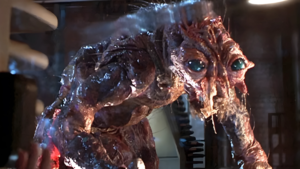
It is more than clear that Kafka not only influenced Burroughs, but Cronenberg’s filmography to a great degree. Now as I wrote before, one should not use the adjective kafkaesque in a thoughtless manner to describe any work that depicts a metamorphosis into an insect. Nevertheless in Naked Lunch after William Lee discovers his wife shooting the insecticide, she tries to convince him into trying this new drug.
Joan: It’s a… it’s a very literary high. Very literary.
[…]
William: What do you mean ‘it’s a literary high’?
Joan: It’s a Kafka high. You feel like a bug. Try some.
William: Well, I don’t know. I don’t know. I think our metabolisms are very different.
Joan: Whose? Yours and Kafka’s?
After injecting himself with the bug powder, William Lee doesn’t transform into a bug, but starts seeing talking bugs among other creatures. Not only that, but his sexual ambivalence towards members of his own sex starts to reveal itself. After accidentally killing his wife (that was accused of being a centipede by a beetle), he travels to the Interzone, where he is instructed to pose as an homosexual and to engage in a sexual relation with Cloquet, a swiss dandy, in order to get information about Dr. Benway. Instead he unintentionally sacrifices Kiki, a friend and lover of his, by letting him get raped by Cloquet, that reveals itself as a gargantuan humanoid centipede himself. The scene of this rape is quite gruesome and involves Cloquet’s pointy insectly legs piercing this young guy’s flesh while penetrating him from behind.
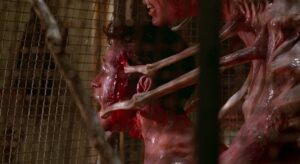
It is known that centipedes in general caused dread to William S. Burroughs himself. This is analyzed at length by Mark Dery, who also links Mr. Burroughs past as an exterminator with his chilopodophobia. On the other hand other authors have established a connection between Burroughs’s fascination for Mayan mythology and his disgust for these little creatures:
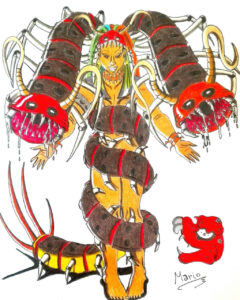
“The secret of Burroughs’s centipede symbol is that priests, the Gods of Death, the one-way senders, turn into giant centipedes – ten foot centipedes rearing up over their victim, a man tied to a couch. And the victim is us.The meaning of the centipede symbol, and of all of Burroughs’ writing, is that when the Gods of Death are in control we live in a wasteland, «the Land Where Anything Goes.»”. (Source Paul H. Wild)
Having read these authors and Burroughs comments on the matter, I wouldn’t infer that the centipede rape scene depicts William Lee’s possible fear of homosexuality; because he had already slept with Kiki some scenes before. I suspect that this is maybe a fear for the worst aspects of the flesh and debauchery of violent sex. The centipede is the potential transformation of the human being into a monster of unrestrained egotistical lust (note that the original title of the book was planned to be Naked Lust). This is the addict and his addiction being amalgamated into a vile uncreature of an insane appetite. This is the ultimate metamorphosis.
- THE INSECT AS A LIAISON TO THE HYPOTEXT
The author-name Franz Kafka functions in Naked Lunch as a Freudian dominating father, who after being killed by his children, comes back to life to haunt them as a communal memory: “Der Tote wurde nun stärker, als der Lebende gewesen war” (my translation to English: “The dead became stronger than when it was alive”). This is the way in which Kafka’s oeuvre, and more specifically The Metamorphosis, permeates the works of authors like Burroughs and Cronenberg.
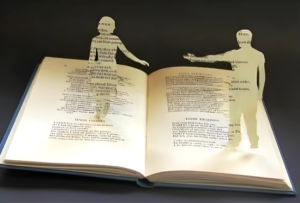
Bakhtin once used the judeo-christian myth of Adam to explain one of his theories. He (Adam) is the first man that came into contact with a virginal world not tainted yet with words and he was the first one to create designations for all phenomena he experienced from his senses. In Bakhtin’s radical interpretation of intertextuality, all the descendants of Adam have not been able to establish a direct linguistic relation to the perceived world, instead they had to rely on the vocabulary that their common ancestor gave to them as a bridge to their own realities. Nothing new can be said, because everything has already been said. It is so that the words of Adam will echo for eternity in the minds and tongues of his sons and daughters.
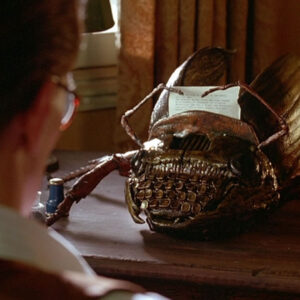
This same arquetype reproduces itself in Naked Lunch. In the film we get to see William Lee experiencing the typewriters as living organisms capable of even talking. These drug addicted beings (like the insecticide enjoying beetle) pass judgment on the material produced on paper to then reward the writer with jizz-like recreational substances if they like what is being written (in the case of the mugwump). It is also suggested that the force exercised on the keyboard arouses them. Not only that, but some of them are jealous and desire to be the only ones, where the writer gets to put his thoughts on.
If in Kafka’s The Metamorphosis a man subdued by an alienating society transforms into a bug, in Naked Lunch the typewriters transform into insect like monsters (exceptuating the mugwump) and become the framework of the writer’s drug fueled fantasy. The image of the typewriter bug is the strongest liaison to the kafkian hypotext. Even though the experiences of William Lee could be somehow unique, they can only be fleshed out on the paper with the guidance of Kafka’s literary corpus. Kafka’s legacy is crucial in order to translate the voice of the author (in the case the stand-in for William S. Burroughs) into the written word. Kafka’s presence in this film thrives even further, to the point that its existence pornographically fleshes itself out in these creatures as the literary framework for the entire movie.
- CONCLUSION
Naked Lunch blurs the lines between the depressive 1950s world of an addict and an arthropodic nightmare where insects are the recorders of the human experience. Even if we don’t see a physical transformation of the main character, all other beings around him fluctuate between inanimate objects and insects; or between humans and giant centipedes.
I deem it as difficult if not impossible for this film to not have existed as it is if Kafka had not written his most famous novel in 1915. Naked Lunch is rich in kafka related intertextuality and not just because “it has bugs or cockroaches”.
On the one hand we have William S. Burroughs, a writer well versed in Kafka’s work, and on the other hand we have David Cronenberg, a filmmaker whose body horror filmography has dealt with the themes of transformation, as creators (in a major or lesser degree) of that 1991 classic. Naked Lunch works as a kafkaesque metamorphosis either in its hallucinatory depictions of talking typewriters or menacing centipedes. The presence of Kafka is so omnipresent, that the film itself would lose its identity if the references were to be removed. Said otherwise and in the most simplest of definitions, Naked Lunch wouldn’t be Naked Lunch without The Metamorphosis, because it is not only an homage to the celebrated czech writer, but it is indeed the DNA of the entire film itself.
- SOURCES
Zurbrugg, Nicholas (1999): „Will Hollywood never learn? David Cronenberg’s Naked Lunch.“ In: Cartmell, Deborah/Whelehan, Imelda (Hgg.): Adaptations. From Text to screen, screen to text. London: Routledge, 99.
Foucault, Michel (1979): “What Is an Author?” In: Josué, Harari (Hg.): Textual Strategies: Perspectives in Post-Structuralist Criticism. Ithaca: Cornell University Press, 141–160.
Grammatikopoulos, Damianos (2017): „Insects and the Kafkaesque: Insectuous Re-Writings in Visual and Audio-Visual Media“ In: Humanities 3:74, 2.
Burroughs, William S. (1974): The Naked Lunch. London: Transworld Publ.
Wild, Paul H. (2008): „William S. Burroughs and the Maya Gods of Death: The Uses of Archaeology“ In: College Literature 35:1.
Freud, Sigmund (1961): „Totem und Tabu“ In: Freud, Anna/Bibring, Edward/Kris, Ernst (Hgg.): Gesammelte Werke. Chronologisch Geordnet. Frankfurt am Main: S. Fischer Verlag (9. Band), 181.
NAKED LUNCH. Canada/Britain/Japan 1991, Director: David Cronenberg, Screenplay: David Cronenberg, Original Language: English.
Unknown, Unknown: „kafkaesque alignment chart“. In: Twitter, URL: https://twitter.com/4rogs_/status/1333202911875231744 [last access: 13.09.2022].
Graham, Uriah: „Naked Lunch Summary“. In: GradeSaver, URL: https://www.gradesaver.com/naked-lunch/study-guide/summary [last access: 13.09.2022].
Dery, Mark: „William S. Burroughs and the Dead-End Horror of the Centipede God“. In: BoingBoing, URL: https://boingboing.net/2014/08/05/william-s-burroughs-and-the-d.html [last access: 13.09.2022].
